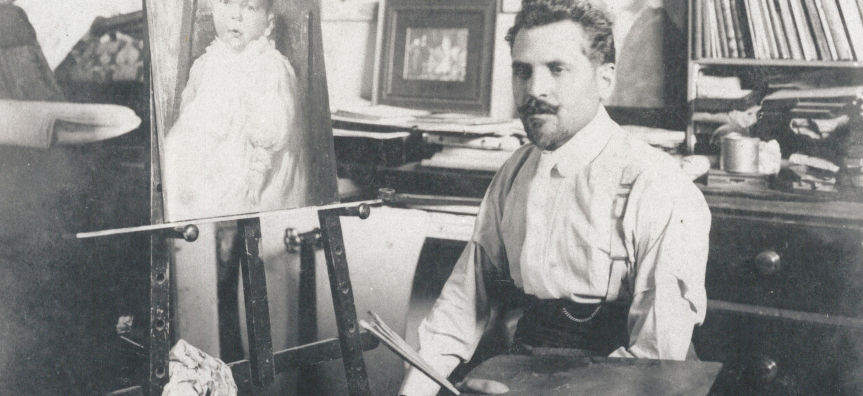
Antonio Dattilo-Rubbo (1870–1955) was a force in Australian art, shaping generations of artists through his teaching, and laying the groundwork for Manly Art Gallery & Museum (MAG&M). Born in Naples, Italy, he trained in Rome and Naples before arriving in Sydney in 1897—an unplanned journey that became a defining chapter in Australian art history.
Dattilo-Rubbo opened an art school for drawing and painting in Australian Chambers, Rowe Street in 1898 and taught at prestigious institutions, including the Royal Art Society of NSW, Scots College, and St Joseph’s College. His impact as a teacher was profound—his students included pioneers of Australian modernism like Roy de Maistre, Grace Cossington Smith, and Roland Wakelin. He encouraged them to explore colour and light, exposing them to European avant-garde movements and setting the stage for the development of modern art in Australia.
As a painter, Dattilo-Rubbo worked across portraiture, landscapes, and genre scenes, exhibiting widely in Australia and internationally. His use of bold colour and dynamic brushwork, influenced by Impressionism and Post-Impressionism, distinguished his work. His portraits were regularly featured in the Archibald Prize, and in 1947, he was commissioned to paint a posthumous portrait of Prime Minister John Curtin.
Dattilo-Rubbo’s connection to Manly was central to his life and career. Moving to the area in 1916, he became a key advocate for establishing a public art collection. In 1924, he joined the first committee of what would become MAG&M, making the gallery’s first donation—his painting Aboriginal Head. Over the years, he continued to support the institution, culminating in his 1940 gift of 100 works on the condition that a dedicated space be created to house them. The Dattilo-Rubbo Gallery remains a lasting tribute to his vision.
A charismatic and passionate teacher, the ‘Signor’, as students affectionately called him, was known for his dynamic presence, strict discipline, and unwavering belief in the power of art. His influence extended far beyond his own practice, shaping the future of Australian painting through his legacy as an advocate and teacher.
Dattilo-Rubbo was recognised for his contributions when he was made a Knight of the Crown of Italy in 1932. However, his later years were marked by challenges, including a brief internment during World War II due to suspicion over his Italian heritage. He continued to teach and paint until his passing in 1955.
Today, Dattilo-Rubbo’s legacy lives on in Australia’s major art institutions and, most importantly, in the generations of artists he mentored. His foundational role at Manly Art Gallery & Museum, along with his dedication to art education, ensures his impact endures.
This text was derived from Jean Campbell’s introduction to the Antonio Dattilo-Rubbo retrospective exhibition at MAG&M from 5 December 1980 to 18 January 1981. The full essay can be found here.
